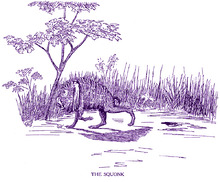Illustration from Fearsome Creatures of the Lumberwoods | |
| Grouping | Fearsome critter Fakelore |
|---|---|
| Folklore | American folklore |
| First attested | 1910 |
| Other name(s) | Lacrimacorpus dissolvens |
| Country | USA |
| Region | Pennsylvania[1] |
The squonk is a mythical creature that is reputed to live in the hemlock forests of northern Pennsylvania in the United States.[1]
Origins
Although the earliest written account of the squonk was from the 1910 book Fearsome Creatures of the Lumberwoods, there are no records of the tale being told in Pennsylvania before the book's publication.[2] The next written iteration, from the 1939 book Fearsome Critters, suggested that the creatures had migrated from deserts to swamps to finally settle in Pennsylvania.[3] As logging camps were continuously moving in the early 20th century, this could explain the "creature's" migration to Pennsylvania.[2]
Appearance and behavior
Unlike many mythological creatures, the supposed physical characteristics of the squonk remain unchanged from the original written account, which states:
The squonk is of a very retiring disposition, generally traveling about at twilight and dusk. Because of its misfitting skin, which is covered with warts and moles, it is always unhappy...Hunters who are good at tracking are able to follow a squonk by its tear-stained trail, for the animal weeps constantly. When cornered and escape seems impossible, or when surprised and frightened, it may even dissolve itself in tears.
— William T. Cox, "The Squonk", Fearsome Creatures of the Lumberwoods (1910)[1]
Later retellings included that squonks were slowest on moonlit nights as they try to avoid seeing its ugly appearance in any illuminated bodies of water. In addition to warts and moles, the creatures were given webbed toes on their left feet.[3]
The given "species" taxonomy of the creature, Lacrimacorpus dissolvens, is made up of the Latin tear, body, and dissolve. These refer to its supposed ability to dissolve when captured.[2]
In scientific literature
Some substances are stable in solution or some other "wild" form but cannot be isolated or captured without actually catalyzing their own polymerization or decomposition ("dissolving in their own tears"). For example, a molecule containing a carboxylic acid moiety and an acid labile moiety might be stable when initially prepared as the salt (e.g., barium prephenate) but unstable as the free acid (prephenic acid). These have been named "chemical squonks" as a nod to the creature.[4]
In popular culture
- The third track on Genesis's 1976 album A Trick of the Tail is titled "Squonk". The song recounts the legend of a hunter who captured a squonk and the creature is described as having a retiring disposition.[5]
- Playwright Daniel Caffrey's play Gregor and the Squonk is loosely based on the tale of J. P. Wentling. Initially written for the short play festival at Florida State University, it was later mounted at Bailiwick Repertory Theatre in Fall 2008 by the Tympanic Theatre Company.[6]
- Steely Dan's song "Any Major Dude Will Tell You" references the legend of the squonk and compares its tears to the narrator's.[7]
References
- ^ a b c Cox, William T. (1910). Fearsome Creatures of the Lumberwoods. Washington DC: Judd & Detweiler, Inc. pp. 30–31.
- ^ a b c O'Neil, Gerard (2014). Supernatural Lore of Pennsylvania: Ghosts, Monsters and Miracles. Arcadia Publishing. ISBN 9781625850263.
- ^ a b Tryon, Henry (1939). Fearsome Critters. Cornwall, New York: Idlewild Press. pp. 48–49.
- ^ Sommer, T. J. (2000). "Chemical squonks The chemical squonk disappears before you can catch it, leaving behind a tantalizing trail of clues". Chemical Innovation. American Chemical Society: 24–28. ISSN 1527-4799.
- ^ A Trick of the Tail (Media notes). Charisma Records. 1976. CDS 4001.
- ^ Gregor and the Squonk at the Bailiwick, Fall 2008
- ^ Steely Dan – Any Major Dude Will Tell You, retrieved 2020-08-28
